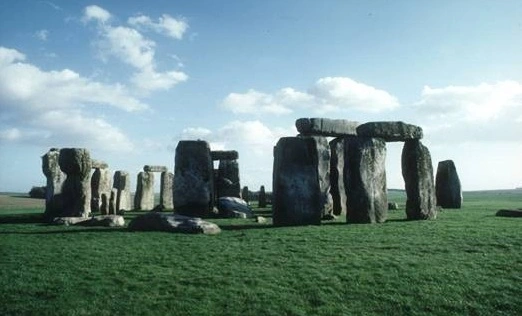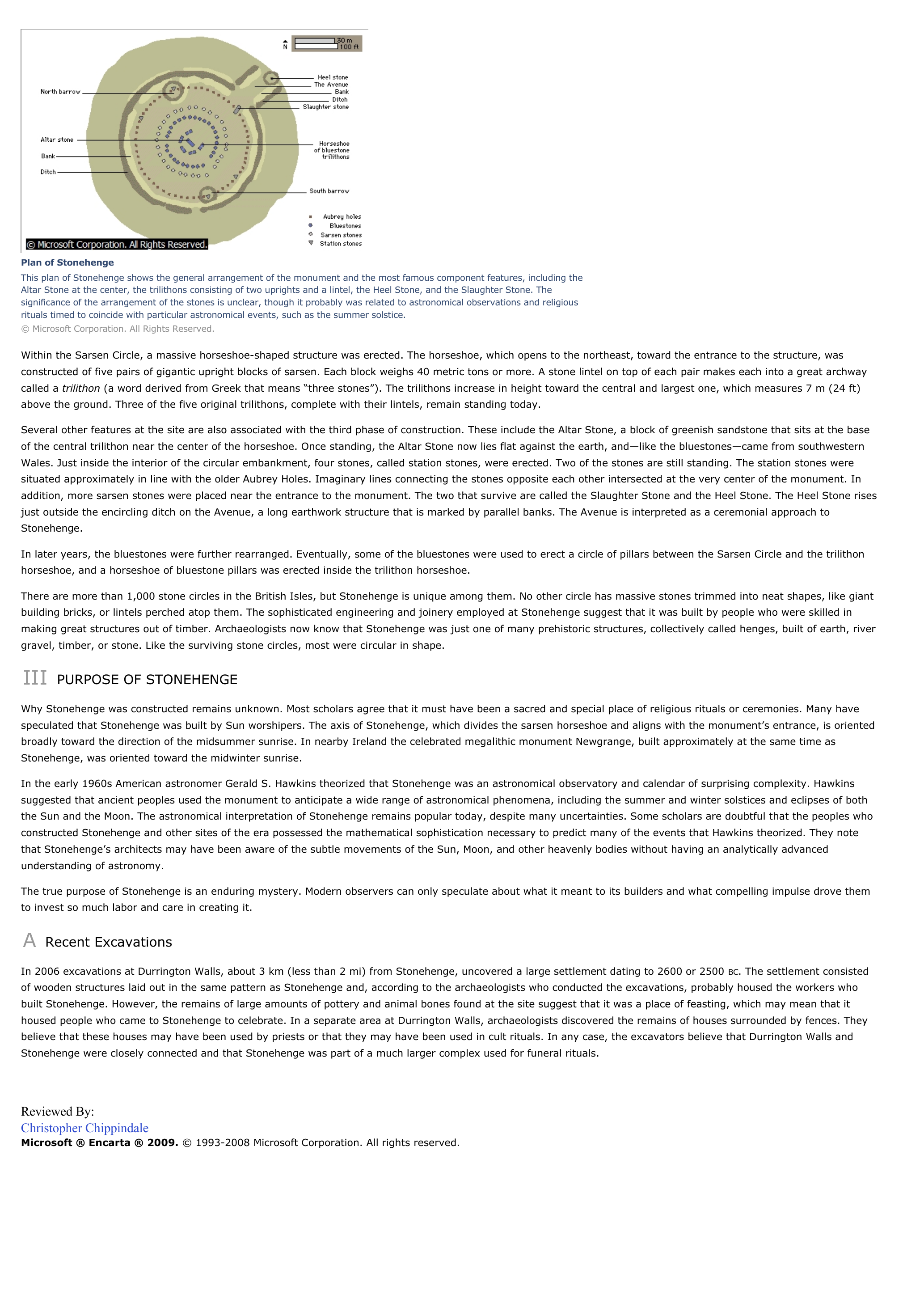Stonehenge - history.
Publié le 26/05/2013

Extrait du document


«
Plan of StonehengeThis plan of Stonehenge shows the general arrangement of the monument and the most famous component features, including theAltar Stone at the center, the trilithons consisting of two uprights and a lintel, the Heel Stone, and the Slaughter Stone.
Thesignificance of the arrangement of the stones is unclear, though it probably was related to astronomical observations and religiousrituals timed to coincide with particular astronomical events, such as the summer solstice.© Microsoft Corporation.
All Rights Reserved.
Within the Sarsen Circle, a massive horseshoe-shaped structure was erected.
The horseshoe, which opens to the northeast, toward the entrance to the structure, wasconstructed of five pairs of gigantic upright blocks of sarsen.
Each block weighs 40 metric tons or more.
A stone lintel on top of each pair makes each into a great archwaycalled a trilithon (a word derived from Greek that means “three stones”).
The trilithons increase in height toward the central and largest one, which measures 7 m (24 ft) above the ground.
Three of the five original trilithons, complete with their lintels, remain standing today.
Several other features at the site are also associated with the third phase of construction.
These include the Altar Stone, a block of greenish sandstone that sits at the baseof the central trilithon near the center of the horseshoe.
Once standing, the Altar Stone now lies flat against the earth, and—like the bluestones—came from southwesternWales.
Just inside the interior of the circular embankment, four stones, called station stones, were erected.
Two of the stones are still standing.
The station stones weresituated approximately in line with the older Aubrey Holes.
Imaginary lines connecting the stones opposite each other intersected at the very center of the monument.
Inaddition, more sarsen stones were placed near the entrance to the monument.
The two that survive are called the Slaughter Stone and the Heel Stone.
The Heel Stone risesjust outside the encircling ditch on the Avenue, a long earthwork structure that is marked by parallel banks.
The Avenue is interpreted as a ceremonial approach toStonehenge.
In later years, the bluestones were further rearranged.
Eventually, some of the bluestones were used to erect a circle of pillars between the Sarsen Circle and the trilithonhorseshoe, and a horseshoe of bluestone pillars was erected inside the trilithon horseshoe.
There are more than 1,000 stone circles in the British Isles, but Stonehenge is unique among them.
No other circle has massive stones trimmed into neat shapes, like giantbuilding bricks, or lintels perched atop them.
The sophisticated engineering and joinery employed at Stonehenge suggest that it was built by people who were skilled inmaking great structures out of timber.
Archaeologists now know that Stonehenge was just one of many prehistoric structures, collectively called henges, built of earth, rivergravel, timber, or stone.
Like the surviving stone circles, most were circular in shape.
III PURPOSE OF STONEHENGE
Why Stonehenge was constructed remains unknown.
Most scholars agree that it must have been a sacred and special place of religious rituals or ceremonies.
Many havespeculated that Stonehenge was built by Sun worshipers.
The axis of Stonehenge, which divides the sarsen horseshoe and aligns with the monument’s entrance, is orientedbroadly toward the direction of the midsummer sunrise.
In nearby Ireland the celebrated megalithic monument Newgrange, built approximately at the same time asStonehenge, was oriented toward the midwinter sunrise.
In the early 1960s American astronomer Gerald S.
Hawkins theorized that Stonehenge was an astronomical observatory and calendar of surprising complexity.
Hawkinssuggested that ancient peoples used the monument to anticipate a wide range of astronomical phenomena, including the summer and winter solstices and eclipses of boththe Sun and the Moon.
The astronomical interpretation of Stonehenge remains popular today, despite many uncertainties.
Some scholars are doubtful that the peoples whoconstructed Stonehenge and other sites of the era possessed the mathematical sophistication necessary to predict many of the events that Hawkins theorized.
They notethat Stonehenge’s architects may have been aware of the subtle movements of the Sun, Moon, and other heavenly bodies without having an analytically advancedunderstanding of astronomy.
The true purpose of Stonehenge is an enduring mystery.
Modern observers can only speculate about what it meant to its builders and what compelling impulse drove themto invest so much labor and care in creating it.
A Recent Excavations
In 2006 excavations at Durrington Walls, about 3 km (less than 2 mi) from Stonehenge, uncovered a large settlement dating to 2600 or 2500 BC.
The settlement consisted of wooden structures laid out in the same pattern as Stonehenge and, according to the archaeologists who conducted the excavations, probably housed the workers whobuilt Stonehenge.
However, the remains of large amounts of pottery and animal bones found at the site suggest that it was a place of feasting, which may mean that ithoused people who came to Stonehenge to celebrate.
In a separate area at Durrington Walls, archaeologists discovered the remains of houses surrounded by fences.
Theybelieve that these houses may have been used by priests or that they may have been used in cult rituals.
In any case, the excavators believe that Durrington Walls andStonehenge were closely connected and that Stonehenge was part of a much larger complex used for funeral rituals.
Reviewed By:Christopher ChippindaleMicrosoft ® Encarta ® 2009. © 1993-2008 Microsoft Corporation.
All rights reserved..
»
↓↓↓ APERÇU DU DOCUMENT ↓↓↓
Liens utiles
- Stonehenge - History.
- Ideology and Rationality in the History of the Life Sciences
- HISTOIRE DU RÈGNE DE L'EMPEREUR CHARLES-QUINT [The History of the Reign of the Emperor Charles V].
- HISTOIRE DU MONDE [History of the World].
- GRANDISON (L') [The History of sir Charles Grandison]. (résumé)
















